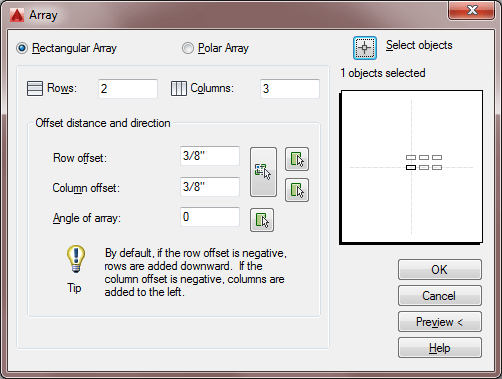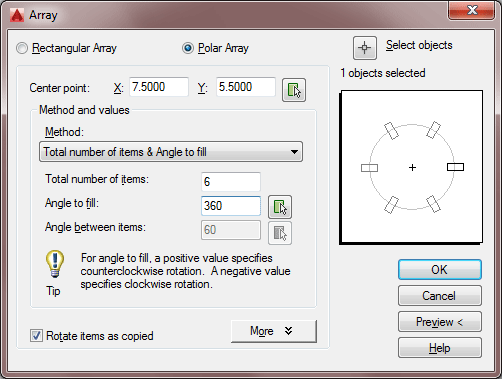Powerfull Modifying Commands
- LESSON 1-1X-Y CO-ORDINATE SYSTEM, INPUTTING POINTS, AUTOCAD SCREEN, BASIC TERMINOLOGY
- LESSON 1-2ASSIGNMENT 1 INTRO TO DRAWING / MODIFYING COMMANDS
- LESSON 1-3MORE MODIFYING COMMANDS / OBJECT SNAPS (TRIM EXTEND OFFSET)
- LESSON 1-4ASSIGNMENT 3 ACCURATE INPUT
- LESSON 1-5SELECTION SETS
- LESSON 1-6ASSIGNMENT 4 MODIFYING COMMANDS (MOVE COPY STRETCH MIRROR)
- LESSON 1-7ASSIGNMENT 5 MODIFYING COMMANDS (ROTATE FILLET CHAMFER ARRAY)
- LESSON 1-8ASSIGNMENT 6 (LAYERS DIMENSIONS TEXT SCALE)
- LESSON 1-9DIRECT DISTANCE ENTRY AND OBJECT TRACKING
- LESSON 1-10CHANGING THE PROPERTIES OF OBJECTS
- LESSON 1-11ZOOMING AND PANNING AROUND A DRAWING
- LESSON 1-12ORTHOGRAPHIC PROJECTION
- LESSON 1-13SECTION VIEWS
- QUIZ FOR LEVEL 1 - 46 QUESTIONS
Topics covered in this Lesson:
Rotate, Fillet, Chamfer, Array
Now it's time to learn a few more commands. Like all of the commands learned so far, these
too will be ones that you will use regularly.
Here are the commands that you will be learning in this lesson.
| Command | Keystroke | Icon | Menu | Result |
|---|---|---|---|---|
| Rotate | Rotate / RO | Home > Modify > Fillet | Rotates objects to a certain angle | |
| Fillet | Fillet / F | Home > Modify > Fillet | Creates a round corner between two lines | |
| Chamfer | Chamfer / CHA |  |
Home > Modify > Chamfer | Creates an angled corner between two lines |
| Array | Array / AR | Home > Modify > Array | Creates a repeating pattern of the selected objects | |
| ArrayClassic | ArrayClassic | none | none | Creates an array using a dialog box for input |
| Circle | Circle / C | Draw > Circle > Center, Radius | Draws a circle from a center point with the radius or diameter |
Once again you will recreate a drawing. This one is called Assignment #5.
Click here to see the GIF format file.
Click here for the DWG file.
Follow the steps shown carefully. As these commands require a little more input, make sure
that you keep an eye on the command line. You will be asked to provide information
throughout the commands.
Start up AutoCAD and load
the
acad.dwt template like you have for the other lessons.
Start by drawing a horizontal 10" X 7" border with the bottom left corner at 0,0
Draw a rectangle 1" wide by 3" tall with the bottom
left corner at .75,.75
You are now going to rotate this rectangle 90° clockwise.
Start the ROTATE command. AutoCAD asks you to select objects. Select all parts of the
rectangle and press <ENTER>. Now you must indicate a 'base point'. Think of this as a
pivot point around which the rectangle will rotate. In this example, you want to select the
bottom right corner (remember to use your Osnap). Once you've selected the base point, the
command line shows rotation angle or [Reference]: This means that 'Rotation angle' is the
default, so type in the angle you want to rotate the object. Think about how AutoCAD measures
angles. Looking at
your rectangle and the one on the assignment sheet, you'll see that you want to rotate the
rectangle clockwise or: -90 degrees. Enter that number and press <ENTER>.
Command: RO <ENTER>
Current positive angle in UCS: ANGDIR=counterclockwise ANGBASE=0
Select objects: <Select the Rectangle> 1 found
Select objects:<ENTER>
Specify base point: <PICK BOTTOM RIGHT CORNER OF THE RECTANGLE>
Specify rotation angle or [Reference]:-90 <ENTER>
The rectangle is now been rotated -90 degrees from its original position. Picking different base points will give you different results. Undo the last command. Try a few different combinations of base points and angles to see what results you get. When you are done practicing, get the rectangle back to the position that it needs to be in.
Make a COPY of the rectangle 2" above the first one (remember your relative coordinates).
Now you're going to modify the second rectangle so that it has rounded corners. Start the FILLET command. Look at the command line. It will look something like this:
Command: F <ENTER> FILLET
Current settings: Mode = TRIM, Radius = 0.0000
Select first object or [Undo/Polyline/Radius/Trim/Multiple]:
AutoCAD first shows you what the current fillet radius is (0.0000). This will be the last
value that was used. Once it's changed, it will keep the new value in memory. The next line
shows you what options you have in this command. Remember that the Capitol of each option
selects that particular option. What you want to do is change the fillet radius to 3/8" (or
.375). To do this you have to type R <ENTER>. When you type this, AutoCAD will give
you the chance to enter a new fillet radius. At this point enter .375 and press
<ENTER>.
The fillet radius is now .375 (which is what you want). The default option is Select first
object. Select the left side of the top rectangle (yes, the whole rectangle will highlight
if you drew it as a rectangle). AutoCAD now asks you to select second object. Select the top
line and AutoCAD will make a smooth round corner with a radius of .375. AutoCAD
automatically ends the command at this point.
Restart the FILLET command and do this to the remaining corners so that you
have an object similar to the example.
BREAK TIME : The Fillet command is commonly used with a Zero radius. This can sometimes be much quicker than trimming two lines that meet at endpoints. To practice this, fillet this lines you made with round corners using a Zero radius.
Copy the first rectangle to a point 4-1/2" above. Now you will use the chamfer command to give this rectangle sharp, angled corners.
Start the CHAMFER command.
This is very similar to the fillet command. You have several options available. Want you want is an even 45 degree angle 3/8" in from the corner. Like the fillet command, you first have to tell AutoCAD what distance you want. To do this, type D to select the Distance option. The command line now looks like this:
Specify first chamfer distance <0.5000>:.375<ENTER></ENTER>
Enter .375 as your first distance. The command line now asks for the second distance. AutoCAD will automatically change the default of the second distance to match the distance you entered for the first.
Specify second chamfer distance <0.3750>:<ENTER></ENTER>
You will then be asked to Select first line. The chamfer command works just like the fillet command. Select the line on the left of the top rectangle. (Don't worry if the entire rectangle highlights.) When prompted to Select second line: select the top line. You will now have a perfect sharp corner at a 45 degree angle 3/8" in from the corner. Do this to the rest of the corners. Look at the command line. It should look like this:
Command: CHA <ENTER> CHAMFER
(TRIM mode) Current chamfer Dist1 = 0.0000, Dist2 = 0.0000
Select first line or [Polyline/Distance/Angle/Trim/Method]: D <ENTER>
Specify first chamfer distance <0.5000>: .375 <ENTER>
<0.3750>:<ENTER>
Select first line or [Undo/Polyline/Distance/Angle/Trim/mEthod/Multiple]: <select one side of the rectangle>
Now look at the assignment sheet and notice the group of six rectangles on the bottom right. You could draw each one individually, but AutoCAD has a command that will allow you to draw one, and it will make the others.
Video: Rectangular Array
Draw a rectangle that is 1/2 unit square with the bottom left corner at 6,1.5 (absolute points). Start the ARRAY command - in newer versions you might see a command line prompt:
Command: AR ARRAY
Select objects: <SELECT RECTANGLE> 1 found
Select objects: <ENTER>
Enter array type [Rectangular/PAth/POlar]: R
Type = Rectangular Associative = Yes
Select grip to edit array or [ASsociative/Base point/COUnt/Spacing/COLumns/Rows/Levels/eXit]: CO
Ambiguous response, please clarify...
COUnt or COLumns? COL
Enter the number of columns or [Expression] <4>: 3
Specify the distance between columns or [Total/Expression] <2">: .375 <ENTER>
Select grip to edit array or [ASsociative/Base point/COUnt/Spacing/COLumns/Rows/Levels/eXit]: R
Enter the number of rows or [Expression] <3>: 2
Specify the distance between rows or [Total/Expression] <2">: .375 <ENTER>
Specify the incrementing elevation between rows or [Expresson] <0">: <ENTER>
Select grip to edit array or [ASsociative/Base point/COUnt/Spacing/COLumns/Rows/Levels/eXit]: <ENTER>
As you can see, it's a lot to enter, but there is another version of this command that you can use. This is the older version of Array now called ARRAYCLASSIC. It will bring up a dialog box that allows you to enter this information and then preview the results. Some people find this easier, especially those of us that have used AutoCAD for a while.
BREAK TIME : There is one significant difference between the ARRAY command the ARRAYCLASSIC
commands.
The ARRAY command will create an "array object" - this is one object that you can then
select with one pick and edit easily.
The ARRAYCLASSIC creates separate objects from each object that is in the array.
Erase the array the you just made and redraw the square. Start the ARRAYCLASSIC command and you'll see this dialog box:

When confronting a new dialog box, I recommend that you look for what is needed from the TOP DOWN to the bottom. This is a great example.
Choose the radio button for "Rectangular Array". This will array the object in a row/column arrangement.
Next select the object you want to array, by picking on the button in the top right corner. (Press enter when done)
Enter the number of rows (going across the page) and column (running up and down the page).
Enter the Row offset. This is this from the bottom left of the original rectangle, to the bottom left of where the first copy will go. Enter the number of columns.
Enter the Column offset
Pick the Preview button to see the array before committing.Pick or press Esc to return to dialog or <Right-click to accept array>:
If the array is correct (check the sample drawing), press right click. If you need to change anything, press the ESC button, make your changes in the dialog box and preview again.
The next time of array used is the polar array. Check out the video if you like before proceeding or just follow along with the tutorial.
VIDEO: POLAR ARRAY
Now you are going to use the ARRAY (polar) command to create the shape in the top right
corner of the assignment.
Start by making a CIRCLE with a center point of 7.5,5.5 and a diameter of 1.5 Next make a
LINE from the center of the circle going 1" to the right (remember your relative input and
Osnaps).
Start the ARRAYCLASSIC command. When asked to select objects, pick the line you just drew.

Examine the dialog box above. Remember to start from the TOP. In this case, you have to select your objects and select a Center Point for the array. (Select the center of the circle.)
If you use the text based ARRAY command, you can still enter in this information as shown below:
Command: AR ARRAY
Select objects: <SELECT THE LINE> 1 found
Select objects: Enter array type [Rectangular/PAth/POlar]: PO <ENTER>
Type = Polar Associative = Yes
Specify center point of array or [Base point/Axis of rotation]:
Select grip to edit array or [ASsociative/Base point/Items/Angle between/Fill angle/ROWs/Levels/ROTate items/eXit]: I <ENTER>
Enter number of items in array or [Expression] <6>: 6
Select grip to edit array or [ASsociative/Base point/Items/Angle between/Fill angle/ROWs/Levels/ROTate items/eXit]: F
Specify the angle to fill (+=ccw, -=cw) or [EXpression] <360>: <ENTER>
Select grip to edit array or [ASsociative/Base point/Items/Angle between/Fill angle/ROWs/Levels/ROTate items/eXit]: <ENTER>
NOTE: Sometimes the Array command can be quicker than the offset command. Think of creating lines for a ceiling grid. You 'could' offset 30 lines one at a time, or you 'should' use the array command to create all 30 lines at once.
Save and print your drawing.
Video: Assignment 5
So far in seven lessons, you have learned many of the common commands in AutoCAD. It may not
seem like a lot, but the idea is to become fluent in them. It should be second nature to run
these commands, as these are the ones you will be using most often. With practice, you won't
need the command line to help you along. Think of the first time you drove a car with a
manual transmission. After time, it got smoother, didn't it. I can't stress enough how
important practice is during these early lessons, especially with these commonly used
commands.
Extra Practice: Copy this drawing - extra_009.gif
Video: Exercise 9
Extra Practice: Copy this drawing - extra_009.gif
Video: Exercise 10
Extra Practice: Copy this drawing using 2 methods. First create the lines using the Offset command, then create the lines using the Array command. Compare which method should be easier, and when you might use one over the other - extra_012.gif
Video: Exercise 12
You Scored:

Fun fact: In 1985, Walker took Autodesk public, and, the following year, he left his position in the company's management in order to pursue his interest in programming.
Please support
MyCADsite.com
Give a donation!
Donate

- To cover this months server costs
- Exceeding amounts will go to creating new content
- Even a penny will help
Did you like the lesson? ❤️
